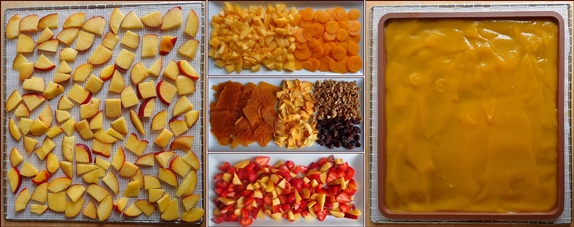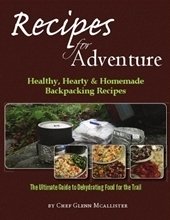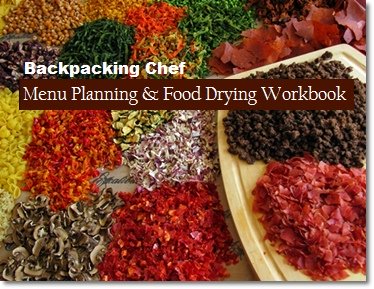Dehydrating Nectarines & Nectarine Fruit Leather
The key to dehydrating nectarines is to start with perfectly ripe nectarines. When you get the ripeness right, dehydrated nectarines are as sweet as peaches, with the extra tanginess that makes them so delicious. This guide shows how to select and dehydrate nectarines, and how to make nectarine fruit leather.
Are you looking for an amazing and healthy backpacking dessert? The page includes a recipe for Carrot-Nectarine Fruit Leather Pudding that you can make in minutes on the trail.
Like peaches, nectarines come in either freestone or clingstone varieties. It’s much easier to slice freestone nectarines uniformly, since the flesh separates easily from the pit. Clingstone nectarines are fine for dehydrating, but you end up with less uniformly-shaped pieces.
With clingstone nectarines, I set aside the flesh that gets trimmed away from close to the pit and use it to make nectarine fruit leather.
Nectarines are an excellent source of vitamins A and C, fiber, and antioxidants. Source: Jersey Fruit.
Table of Contents
Selecting Ripe Nectarines
Selecting ripe nectarines can be tricky, but if you get home and discover that your nectarines are not ripe, wait two days for them to continue ripening at room temperature. It helps to store them loosely in a paper bag until ripe.
Look for a little give when you gently squeeze nectarines. Super-hard nectarines may not have been ripe when picked. They will be less sweet, no matter how long you wait to cut them.
If the nectarines are soft with wrinkled skins, they may be overripe.
The skins will have various shades from light-yellow to golden-orange to red. Leave any nectarines that still have shades of green in the bin, as that would indicate that they were picked too early.
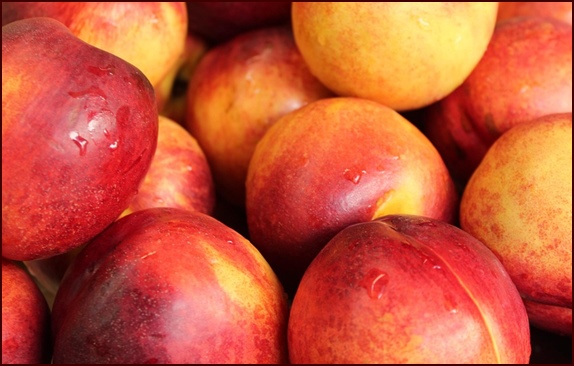
Photo: These nectarines look perfect for dehydration, but let’s give them the sniff test first.
Sniff test: Take a whiff at the stem end. Nothing? Put it back in the bin. The keepers will have a little sweet or fruity aroma. Avoid nectarines that are overly pungent, as that may be a sign that fermentation has begun.
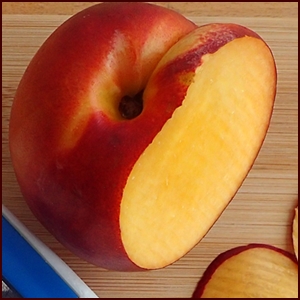
Nectarines come in either white or yellow-fleshed varieties.
White-fleshed nectarines taste sweeter than yellow-fleshed varieties because they are lower in acid.
Yellow-fleshed nectarines have a tangy flavor due to the higher acid content. They don’t lack sweetness; it’s just nicely balanced with the tartness.
I love both kinds, and the contrast of colors is nice when you combine them in a dried fruit trail mix.
How to Dehydrate Nectarines
Nectarines may be dried with or without the peels. Keeping the peels on adds nutrition to the dried nectarines, but they will be slightly chewier. Be sure to wash the nectarines if you leave the skins on.
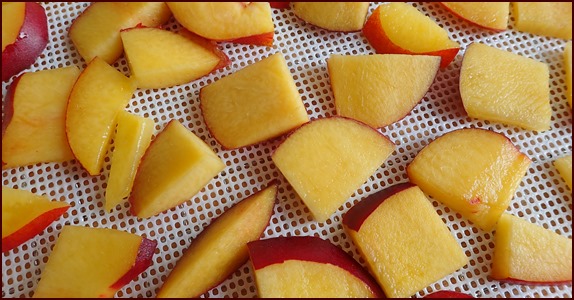
Photo: Sliced nectarines on silicone mesh dehydrator sheet.
Slicing:
Cut nectarines into uniformly-thick slices between ⅛-inch and ¼-inch thick.
With a freestone nectarine, cut the nectarine downward from the stem into four quarters, then cut each quarter crosswise into slices of equal thickness.
With a clingstone nectarine, cut slices downward starting from the outside of the nectarine until you reach the pit. Then rotate the nectarine in quarter-turns, slicing from the outside to the pit. A mandoline slicer is useful to make cuts of equal thickness, but a knife will do.
Trim away the remaining flesh from around the pit to use for making nectarine fruit leather.
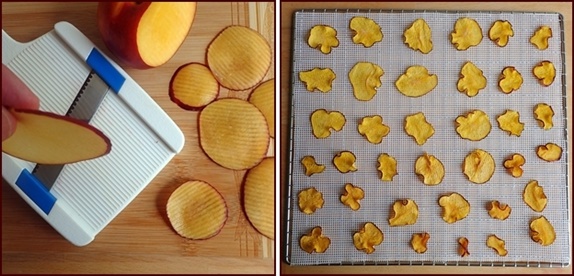
Photos: Slicing nectarines with a mandoline slicer (left), dehydrated nectarine chips (right).
In the photos above, I experimented with dehydrating nectarines extra-thinly (less than ⅛-inch thick) into “nectarine chips.” While they were nice to look at, in a taste-test, they didn’t deliver the full sweet-tangy flavor compared to thicker sliced nectarines (⅛-inch to ¼-inch thick).
Dehydrating Nectarines
Place sliced nectarines on dehydrator mesh sheets in a single layer with a little space between the pieces.
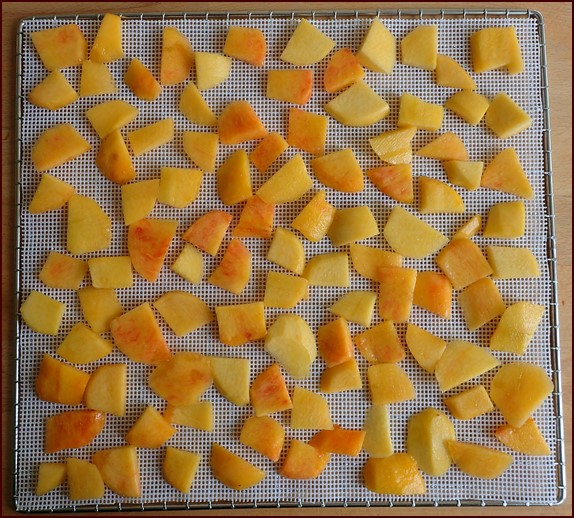
Photo: Dehydrating nectarines on Cosori dehydrator tray using a silicone mesh sheet.
Dehydrate nectarines at 135°F (57°C) for approximately eight hours. Dried nectarines will be pliable with no moisture appearing when you tear a few pieces in half.

Photo: Dehydrated nectarine slices.
Storing Dehydrated Nectarines
Place dried nectarines in an airtight container. Mason jars and Mylar bags used in combination with oxygen absorbers are ideal for long-term home storage.
Conditioning: Check the jar for two to three days to make sure no moisture appears on the inside of the jar. If you see moisture, put the nectarines back in the dehydrator to finish drying.
A Ziploc bag is sufficient to carry dehydrated nectarines for a week on the trail. For longer trips, consider vacuum sealing as the best way to protect the fruit from air and moisture.
How to Make Nectarine Fruit Leather
Make nectarine fruit leather with just nectarines or combine nectarines with other fruits or vegetables. Nectarine fruit leather can be eaten as a quick snack on the trail or easily rehydrated into fruit smoothies and puddings.
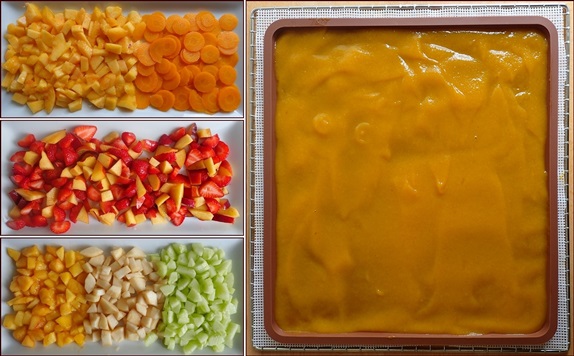
Photos: Nectarines plus other fruits and vegetables make wonderful fruit leathers.
Nectarine Fruit Leather Recipes
Steps for Making Nectarine Fruit Leather
Nectarine & Mixed Fruit Leather
Making Nectarine Fruit Leather
To make one nectarine fruit leather, cut fruit into pieces until you have two cups (300 g).
If you leave the skins on, the fruit leather will be more nutritious, but the color will be a little darker with specks of nectarine skin in the finished leather.
Run the nectarine pieces through a blender to a smoothie-like consistency, adding 1−2 tablespoons of water if necessary to help the blender.
Yield: 300 grams of nectarine pieces will yield approximately 1¼ cups of blended nectarines, which is a good quantity to spread on one dehydrator tray.
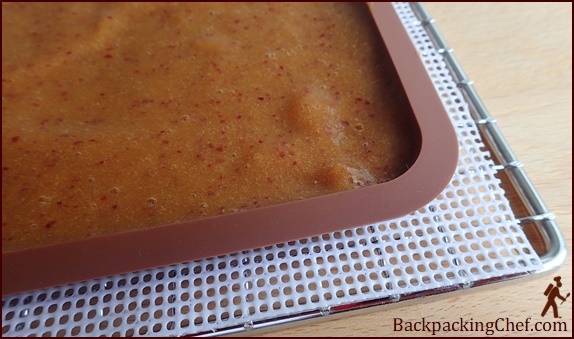
Photo: 100% nectarines blended with skins spread thinly on silicone dehydrator tray.
Dehydrating Nectarine Fruit Leather
Spread blended nectarines thinly on nonstick dehydrator trays. Silicone trays with raised edges are great for holding blended fruits, and they have excellent nonstick properties and are super-easy to clean.
Dehydrate nectarine fruit leather at 135°F (57°C) for approximately 8−9 hours.
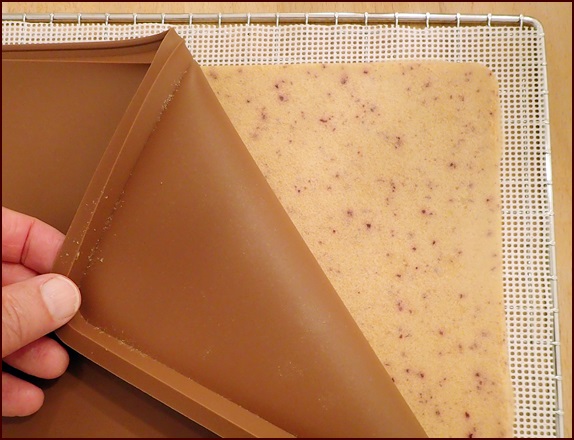
Photo: Pineapple-nectarine fruit leather flipped onto silicone mesh sheet when close to dry with silicone tray peeled off.
When the leather is substantially dry after seven hours, flip the tray over onto a mesh sheet and peel off the silicone tray. This will ensure the fruit leather is completely dry.
Dried nectarine fruit leather will be pliable. You should be able to fold it without it snapping into pieces.
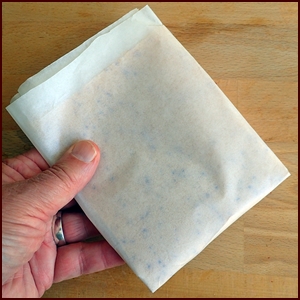
As soon as it is dry and cool, fold nectarine fruit leather up in three columns using parchment paper and then fold that in half. This will keep it from sticking to itself, and it makes it easy to store two or three fruit leathers in a sandwich-size Ziploc bag for the trail.
Store at home in a closed container to keep the leather from reabsorbing moisture from the air.
Nectarine Fruit Leather Smoothie
Fruit leather smoothies make nutritious breakfast beverages on the trail, and they are wonderfully refreshing in the afternoon during summer backpacking trips.
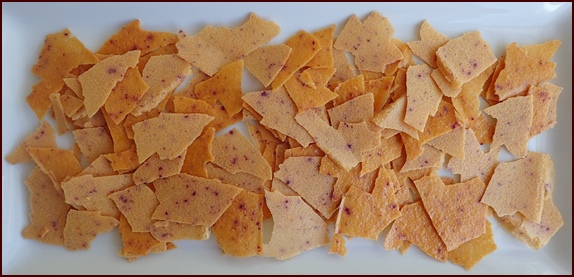
Photo: Pineapple-nectarine fruit leather torn into pieces before rehydrating into a smoothie.
Tear one sheet of fruit leather into pieces and combine with one cup of cold water. Stir vigorously or shake in a container with a lid. It takes 5−10 minutes to rehydrate into a smoothie. It will thicken the longer you wait.
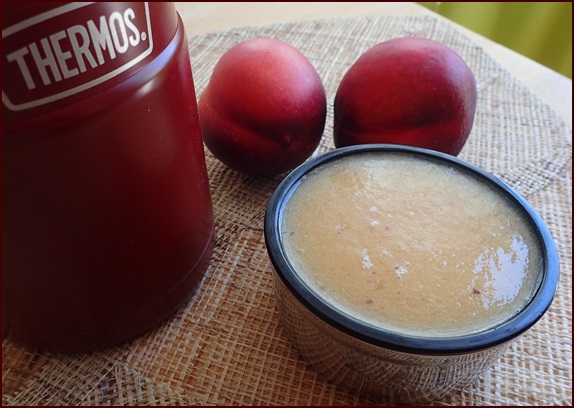
Photo: Pineapple-nectarine fruit leather rehydrated into a smoothie.
Nectarine & Mixed Fruit Leather
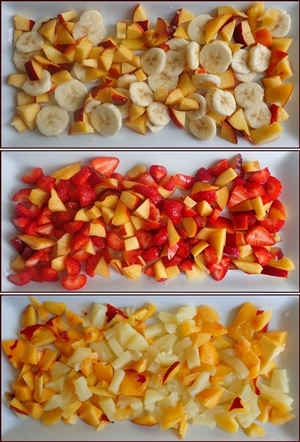
Use 300 grams of combined fruit to make one fruit leather, in any proportion that you like. I recommend adding no more than 50% of the second fruit so that you don’t overpower the flavor of the nectarines.
Nectarines go well with bananas, strawberries, pineapples, pears, peaches, and apples.
Add 1−2 tablespoons of water or fruit juice to help the blender if necessary. You won’t need any extra liquid with strawberries, since they have a high-water content.
Spread blended fruit thinly on nonstick trays and dehydrate for approximately 8−9 hours at 135° F (57°C) until dry, but still pliable.
Photo: 1¼ cups (300 g) of blended nectarines and bananas on silicone dehydrator tray.
Nectarine, Pear & Cucumber Fruit Leather
This fruit leather combination is light and delicious!
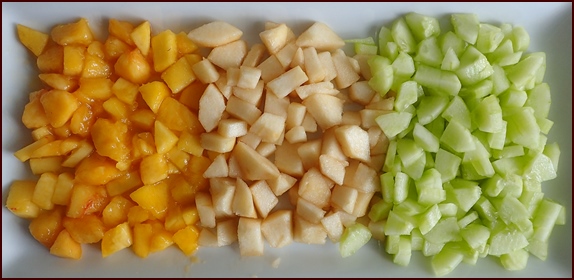
Photo: Nectarines, pears, and cucumbers; ready to be blended into fruit leather.
Peel skins and remove seeds from the cucumbers for the best color and texture.
Use 125 grams each of nectarines, pears, and cucumbers, for a total of 375 grams. This will provide 1¼−1½ cups after blending.
Add one teaspoon of honey to the blender before blending.
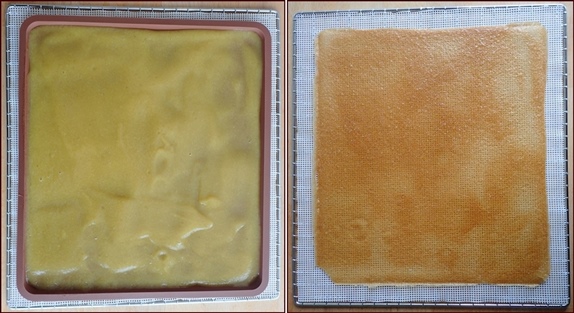
Photo: Blended nectarines, pears, and cucumbers, before and after dehydration.
Spread mixture evenly on nonstick dehydrator tray and dehydrate at 135°F (57°C) for approximately eight hours. Flip leather onto a nonstick mesh sheet after about six hours when it is almost dry. Peel off the nonstick sheet and continue drying until leather is pliable.
Carrot-Nectarine Fruit Leather
Here’s a delicious way to add a vegetable to your backpacking menu. Carrots are high in vitamin A. This carrot-nectarine fruit leather makes an amazing pudding when rehydrated with hot water for dessert.
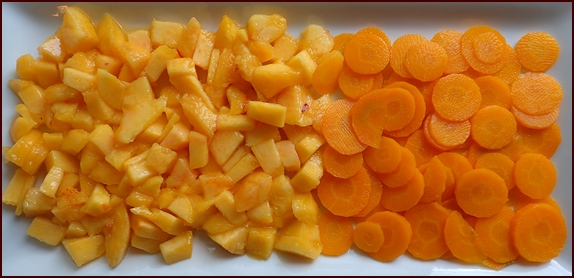
Photo: Nectarines and steamed carrots before blending into fruit leather.
Ingredients for 1 leather:
- 250 g nectarines
- 100 g steamed carrots
- 1 tsp. honey
- ¼ tsp. cinnamon
Steps:
Peel and slice carrots and steam them for six minutes to soften them up and to enhance the orange color.
Let steamed carrots cool, then combine with other ingredients in a blender. Blend until smooth.

Photo: Carrot-nectarine fruit leather before & after dehydrating.
Spread mixture evenly on nonstick dehydrator tray and dehydrate at 135°F (57°C) for approximately eight hours. Flip leather onto a nonstick mesh sheet after about six hours when it is almost dry. Peel off the nonstick sheet and continue drying until leather is pliable.
Carrot-Nectarine Fruit Leather Pudding
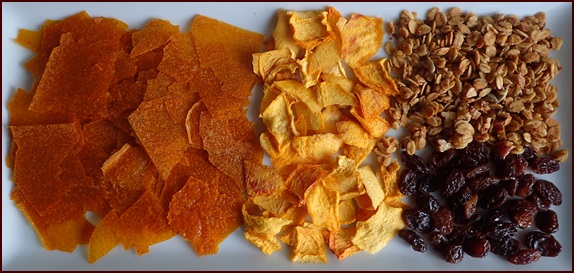
Photo: Carrot-nectarine fruit leather, dried nectarines, granola or nuts, and raisins.
Servings: 1 or 2
One hungry hiker can easily polish off the whole serving. Trust me, I know.
Ingredients:
- 1 sheet carrot-nectarine fruit leather (45−55 g)
- ¼ cup dried nectarines (15 g)
- ⅛ cup granola and/or nuts (20 g)
- ⅛ cup raisins (20 g)
- 1 cup hot water to rehydrate (236 ml)
Pack fruit leather and dried nectarines separately.
On the Trail:
Add boiled water to the fruit leather and dried nectarines in a bowl, or you can add these items to boiled water in a pot.
Leather will reconstitute in seconds but give the dried nectarines 5−10 minutes to soften up. Stir until smooth.
Stir in granola, nuts, and raisins.
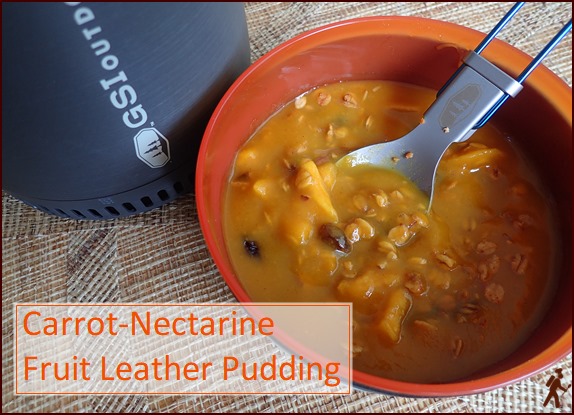
Photo: Carrot-Nectarine Fruit Leather Pudding.
You’re going to love this pudding!
Frequently Asked Questions
Do
you need to peel nectarines before dehydrating them?
Do
you need to peel nectarines before dehydrating them?
No, you don’t have to peel nectarines before dehydrating. Keeping the skins on adds extra nutrients, though the texture will be slightly chewier. Just make sure to wash them thoroughly first.
How
thick should I slice nectarines for dehydrating?
How
thick should I slice nectarines for dehydrating?
Slice nectarines between ⅛-inch and ¼-inch thick for best results. Thinner slices will dry faster but may be less flavorful. Thicker slices retain more of the sweet-tangy taste.
How
long does it take to dehydrate nectarines?
How
long does it take to dehydrate nectarines?
At 135°F (57°C), dehydrating nectarines takes about eight hours. Time may vary depending on slice thickness and humidity. The fruit should be pliable with no visible moisture inside.
How
do I store dehydrated nectarines for the long term?
How
do I store dehydrated nectarines for the long term?
Store dried nectarines in airtight containers like Mason jars or Mylar bags with oxygen absorbers. Keep them in a cool, dark place. For trail use, Ziploc bags are fine for short trips.
What’s
the best way to make nectarine fruit leather?
What’s
the best way to make nectarine fruit leather?
Blend two cups of chopped nectarines (skins optional) into a smooth purée and spread it thinly on a nonstick dehydrator tray. Dehydrate at 135°F (57°C) for 8–9 hours until fully dry but still pliable.
How
long does nectarine fruit leather last?
How
long does nectarine fruit leather last?
When stored in a sealed container in a cool, dry place, fruit leather can last up to a year. For trail use, pack it in parchment paper and a Ziploc bag to keep it from sticking.

Ask Chef Glenn
If you have a question after reading this page, send it to me, and I’ll get back to you soon.
Dehydrator Accessories
Shop Amazon for the Cosori dehydrator and accessories used for dehydrating nectarines and nectarine fruit leather on this page. The silicone trays and silicone mesh sheets are flexible, truly nonstick, and are very easy to clean. Mesh sheets can be cut to size with scissors. These dehydrator accessories will ensure you get excellent results for all your food drying projects.

Left: Silicone Dehydrator Trays with Raised Edges, 11.8" x 10.8", 6-Pack
Middle: Cosori Dehydrator, Stainless Steel, 6-Trays
Right: Silicone Mesh Dehydrator Sheets, 14” x 14”, 12-Pack
Disclosure: As an Amazon Associate, Backpacking Chef earns from qualifying purchases. Thank you!
Dehydrated Nectarine Storage
Vacuum Sealer Accessory for Mason Jars
Explore More…
Guide to Dehydrating Peaches & Peach Fruit Leather
Share this page with friends on social media.
Free E-book & Newsletter
Free with Trail Bytes subscription.
Dehydrating Food from A–Z

